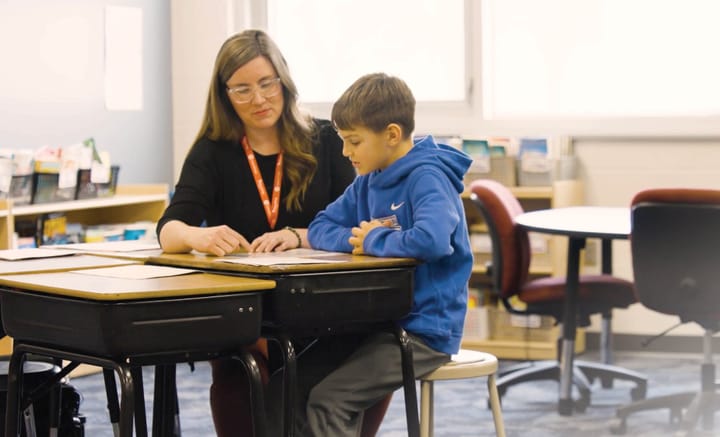Group, community say more flexibility needed in treating trafficked youth
Study also needed to determine extent of problem, fuller solutions

Taryn Sveet, principal at Beach Public High School, is tired of an algorithm deciding when students are discharged from her classrooms only to see them ricochet back months later.
“It is really hard to watch them come back the second and third time because every time a little bit more is gone,” Sveet said. “A little bit more of their hope for the future is gone. When you have no control of them going out, it’s hard to watch.”
Those students are residents at Home on the Range, a therapeutic ranch and qualified residential treatment program nestled on the rolling prairie just a few miles east of town. It is a working ranch where youth residents train with therapy horses and canines, where they work outside and study and build themselves back up with support of trained staff.
Many have severe trauma from being sexually trafficked. Some have problems related to drugs or alcohol. Deep emotional scars lead to issues trusting others and trusting themselves.
A federal policy aimed at keeping children from languishing in institutionalized care, the Family First Prevention Services Act, and adopted in North Dakota in 2019, changed how facilities like Home on the Range operate.
While well-meaning, the policy limited residential treatment of children to no more than 18 months of total time between the ages of 12 to 18.
However, those in the community and the facility say most kids are being discharged after one, two or three months, and that this is often not enough time for treatment. That’s especially important for sexually trafficked youth who need more space to adjust to the facility, staff and their peers, they say.
State-mandated assessments that rely on algorithms to determine when youth should go back to their families or into foster care are also inflexible and lead to further disruptions, especially to education, they say.
When they go to a facility, residents have a Child and Adolescent Strengths and Needs assessment conducted. Following this, they are evaluated by a system run by third-party vendor, Maximus Ascend out of Franklin, Tennessee.
While approximately 10 case managers working for the company in North Dakota review treatment recommendation and connect with their families about their treatment, a clinician based at the headquarters conducts the final monitoring and review.
“I’ve literally had kids in my office ask, ‘What do I need to do, should I go get into a fight? I bet if I get into a fight, it’ll tick it off and I’ll get to stay,’” Sveet said of how some youth attempt to game the algorithm to stay longer. “That should never ever be a conversation I have with kids, ever, when we’re trying to rehab them and send them out into society.”
Sveet said students from the facility who go through the high school are discharging more quickly, often in the middle of a semester, and there’s little heads up about when they’ll leave.
The school usually only finds out what school they went to after they return due to problems adjusting to their new situation, often at schools in rural areas with no system to support their continued recovery from years of trauma, said Samuel Kerr, administrator for classes at the East Campus located at the facility.
“I think we’re a little tired of being out here on the front lines and no one is listening to us, or even asking us,” Kerr said of the lack of connection with state authorities about the needs of these students.
“We used to have a lot of kids that would graduate,” Sveet said. “We used to have them for a year, two years and had some sort of ability to keep them longer and work on it.”
Laura Feldmann, executive director of Home on the Range, said when she graduated from Beach High School in the early 1990s that the “vast majority” of kids at the facility went to the school.
“So I know like in my sister's class, one of the Home on the Range kids was the homecoming king,” she said. “The kids participated on the sports teams. You know, it was pretty, pretty integrated, I would say.”
Things are different now. Of the 57 students from Home on the Range that have taken classes through or at the high school in the last school year, only 37 percent received credits, according to school statistics.
The year before, only 33 percent out of the 70 students got credits. On average over both years, 40 percent of those students left before credits could be awarded. Often those credits aren’t accepted at their new schools, staff said.
Brittany Fode, licensing unit administrator at the department of Children and Family Services (CFS), said it is important to point out that before the state adopted the Family First policies, it was among the top three states in the country for placing foster care youth in residential treatment programs.
“That’s not anything that we should be proud of, that we, as a small state were placing children at one of the highest rates in the country,” Fode said.
Fode also notes that Maximus Ascend is not new to North Dakota and was involved with residential placement in psychiatric treatment centers and assessments for nursing home placement prior to their role with residential treatment placements.
“Clinicians from Maximus Ascend, leadership from CFS, and then also clinical leaders from our human service center, meet regularly,” Fode said. “We review approvals, we review denials, we review the algorithm which really says, you know, can this child's needs be met in the community and if not, what is the best placement for them?”
Data gaps
Changes that would have carved out room for facilities like Home on the Range to create more specific programs for sexually trafficked kids outside the Family First rules appeared on the verge of being approved earlier this year.
Senate Bill 2341, which included the proposals, was initially supported with a 47-0 in favor vote in the Senate before going to the House where it was amended down to a study bill.
In March, officials from the Department of Health and Human Services argued that data on the exact number of sexually trafficked youth was inconsistent and that a new level of foster care would create administrative burdens and increased budget costs.
During the study, which has just started and will last into next year, state officials hope to get a better handle on just how many youth have been sexually trafficked and if there are better treatment options for them.
North Dakota Child Welfare data, for example, only confirmed three sexually trafficked youth from July 2021 into the current period. Juvenile Court data found 27 suspected or confirmed cases since 2020.
The state’s own Human Trafficking Task Force indicated 152 confirmed or suspected cases of youth trafficking since 2015. The group Youthworks documented that it served 200 youth who were suspected, confirmed or at risk of trafficking from 2019 to 2021.
“So when we see that the data is not consistent, and there were various definitions from agencies about what a confirmed victim is versa what a suspected victim is, and how that data was tracked, it was truly very unclear on how many children in North Dakota foster care would actually need a residential level of sex trafficking treatment,” said Fode.
Fode said the purpose of the study is to identify one tool to ensure data is consistent. From there, the study would find a standard framework that could be applied to all levels of foster care, not just a residential facility, she said.
As for Home on the Range, its most recent data shows that between Jan. 1 and Sept. 1, 2023, of the 27 girls who have been residents at the facility, eight are confirmed sex trafficking cases, 15 are suspected, and 3 others were possibly trafficked but evaded questions. Nine out of 25 boys resident at the facility this year also fit the trafficked category, though only one was a confirmed case.
More trauma, more complexity
The need is there for facilities like hers, Feldmann said, to treat sexually trafficked and abused youth over a longer period. She would like to have more flexibility where a resident, the staff, and other agencies including local educators, could all determine the best path forward on a more equal basis.
“Now you're getting complex trauma kids who have a significant history of sexual abuse who have been incredibly aggressive or assaultive,” Feldmann said. “Kids who are trafficked, and by their family. So these are kids who one, have nothing to lose, two don't have any trusting adult.”
Feldman said the ability to care for a youth trafficking victim only one, two or three months at a time is not enough. It’s a “continuous starting from scratch,” she said.
“At the end of that 30 days, that kid might go back to the family that got them to be in placement in the first place. That kid might go to a courthouse to sleep in a back room, they might go to a hotel to sleep, they might go to a worker’s office until they could find a place appropriate for that kid,” she said.
“If they're here for a year, you've got a lot more time to stabilize them, and then to work on that relationship, and help them to learn that not all adults suck,” Feldman said.
Home on the Range, was originally established in 1950 by Fr. Elwood E. Cassedy as a home for orphaned boys, then started offering services for girls in 1990. It is supported by foundations, private donations and the Catholic Church’s Bismarck Diocese, which provides a chaplain for the facility.
The state used to have 12 facilities offering similar services to foster youth, sexually trafficked children and others with problems like truancy and other behaviors, but this dropped to only two after the Family First policies came into place. Another is Lutheran-affiliated Dakota Boys and Girls Ranch, with operations in Minot, Fargo and Bismarck.
Fr. Nicholas Vetter, chaplain at Home on the Range since July, said he often hears of misconceptions about the youth residents at the facility because times have changed while perceptions haven’t. He said trauma needs to be highlighted over the word troubled.
“We are dealing with a substantially different issue here. Not just a kid who got in trouble a few times.”
Three months or less is not enough to really make inroads, he said.
“I mean, to tie their shoes it takes kids longer than three months almost, you know. Then talk about kids who have been traumatized, who've been abused since 5, 7, 8 years old, sold in the sex trafficking at 12 years old, at 14, you know, doing meth, serious drugs at 16 years old,” Vetter said. “What can you really do in three months?”
The North Dakota News Cooperative is a nonprofit news organization providing reliable and independent reporting on issues and events that impact the lives of North Dakotans. The organization increases the public’s access to quality journalism and advances news literacy across the state. For more information about NDNC or to make a charitable contribution, please visit newscoopnd.org. Send comments, suggestions or tips to michael@newscoopnd.org. Follow us on Twitter: https://twitter.com/NDNewsCoop.



